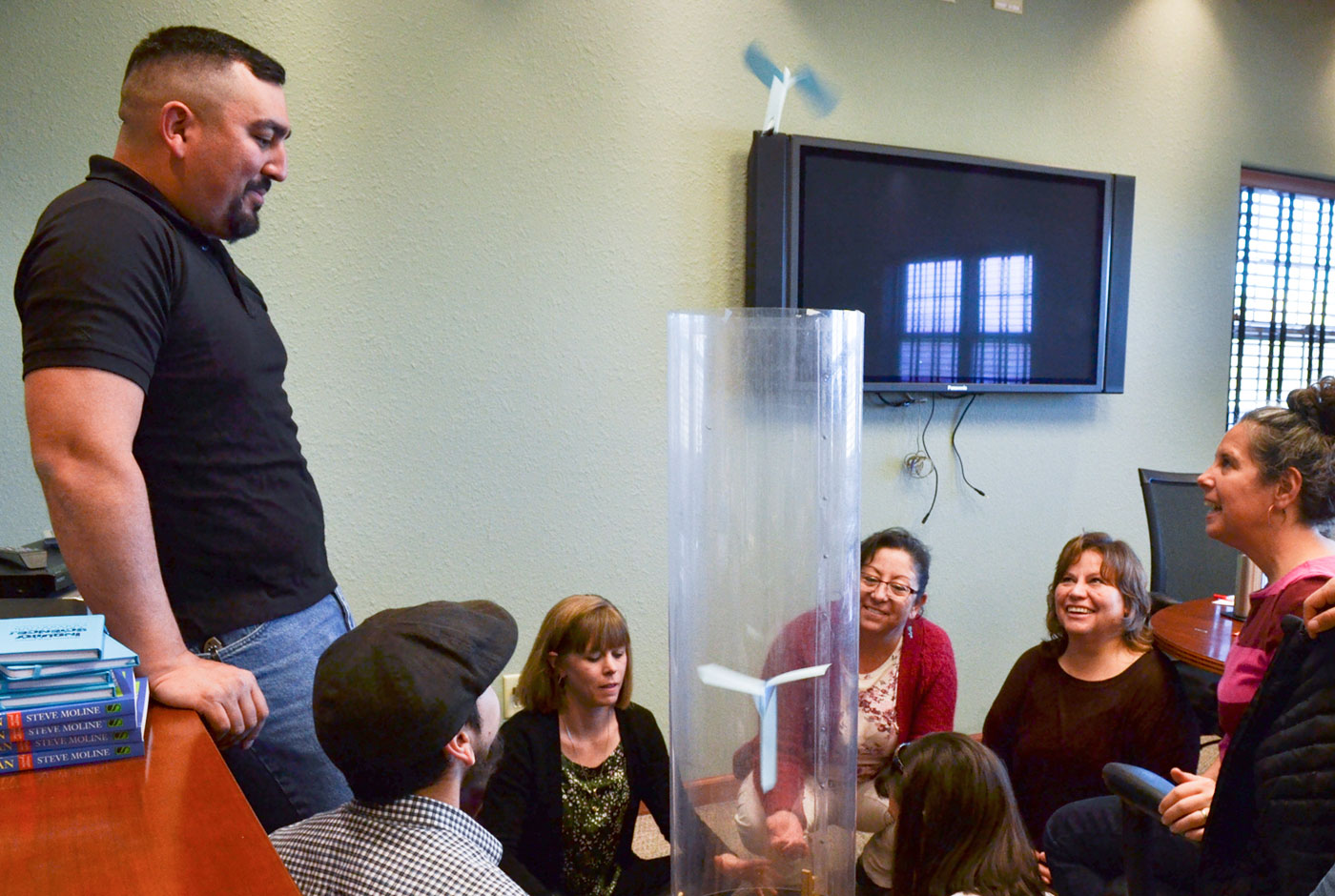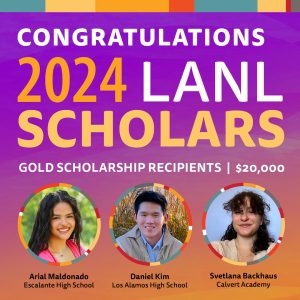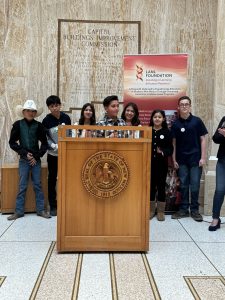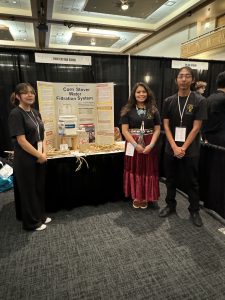If you think that engineering can only be learned in upper grade levels, think again! Inquiry STEM activities designed for early childhood set the stage for further learning in language development and science practices, including basic engineering concepts. The ISEC team is investigating the implementation of Pre-K curriculum modules for children ages 0 to 5, with the help of ¡Explora! Museum and some local preschool teachers.
“At this age, children are doing everything from counting to estimating, predicting, observing, collaborating, measuring and recording data and ideas,” said Tara Henderson, Director of School and Community Programs at Explora in Albuquerque. “It’s playful and fun, but all of these basic science process skills are being developed that are lead-ins to the science standards.”
With funding from the New Mexico Library Foundation and a grant Explora received from the Institute of Museum and Library Services, Henderson and her staff go out into the community to teach and guide hands-on learning activities and provide materials and curriculum to libraries.
STEM to Read, an early and pre-literacy program designed by Explora, offers public libraries “activity trunks” that can be borrowed from the State Library for six to eight weeks. Each trunk is created specifically for preschool children and contains books, information, lesson plans and materials for activities focuses on a specific component of STEM.
After hearing about the program, LANL Foundation’s ISEC staff attended a training at the Embudo Library and started to work with Explora to integrate the pre-K curriculum as a pilot under the Inquiry Science Education Consortium model. ISEC currently offers materials, curriculum and teacher professional development in 44 elementary schools.
LANL Foundation staff during the pre-K training (L to R): ISEC Professional Development Coordinator Doris Rivera, ISEC Science Resource Center Materials Specialist Isaac Ortiz, ISEC Program Manager Bryan Maestas and ISEC SRC Manager Monica Herrera.
The movement of paper Twirly Birds can be explored by dropping them by hand from above or releasing them in a wind tunnel, as Nye Early Childhood Center pre-K Tara Hughes is seen doing here.
Henderson led a recent training at the LANL Foundation office for ISEC and teachers selected to take part in the pilot program.
Ruby Mestas, a pre-K teacher at Chama and Tierra Amarilla Elementary Schools, and Brittany Behenna Griffith and Tara Hughes, special education/pre-K teachers at Nye Early Childhood Center in Santa Fe, came alive as they began to dig into the materials.
Tara Henderson (left), Director of School and Community Programs at Explora in Albuquerque, reads a book associated with the engineering lesson as Ruby Mestas, pre-K teacher at Chama and Tierra Amarilla Elementary Schools, builds a tower.
Explora has designed curricula for 17 different subject areas, but the ISEC pilot will focus on just two: “Engineering Designers” and “Bubbles, Bubbles, Bubbles.”
Science Resource Center Materials Specialist Isaac Ortiz (right) will oversee the pre-K project that includes management of hundreds of materials and delivery logistics in collaboration SRC Manager Monica Herrera (left).
The engineering curriculum includes bridge building, towers, launching levers, scribble bots, twirly birds and gliders and making silly slime. ISEC will stock all of the needed materials in the warehouse and deliver them directly to the participating schools.
The group builds then watches the scribble bots draw patterns on paper.
“Explora’s done a wonderful job of creating the kits aligned with New Mexico standards,” said Bryan Maestas, ISEC Program Manager. “They offer the curriculum and training, then give us the ability to do the purchasing and build the kits.”
As part of the programs’ emphasis on leadership development, Science Resource Center Materials Specialist Isaac Ortiz will oversee the pre-K project. He’s looking forward to taking on the new responsibility of ordering materials, managing the inventory, packing the trunks form scratch beyond his regular warehouse duties for the elementary program. He’s also excited to do some of the learning activities at home.
“This is my first project to lead. A lot of this is new for me and a learning experience,” he said. “My son, Logan, would love the bubbles,” said Ortiz. “He can really focus on things now at four months.”
Maestas also sees the excitement of hands-on learning in his three-year-old daughter, Bryn. “Kids are sponges at this age, the more they are exposed to, the more they learn. Bubbles are her favorite part of Explora, and she loves building things like pillow forts and clamping blankets together. She’s even starting to read,” he beamed.
(L to R) Pre-k teachers and participants in the pilot program Ruby Mestas, Brittany Behenna Griffith and Tara Hughes explore bubbles with their three-dimensional wands during training.
The bubbles kit involves activities around blowing hard and soft, observing colors, the difference between bubbles produced in a salt water and plain water solutions, testing different types of soap to make the best bubbles, comparing size and how long they last, bubble watercolor paintings, and the chemistry of mixing in other materials like baking soda, vinegar or lemon juices.
Activity cards are available for families to take home and replicate the explorations together using everyday materials.
The literacy component is a large part of each lesson, with a book that illustrates the activity through a story.
“We get the books too?!” exclaimed Behenna Griffith in surprise.
Henderson explained how she likes to introduce new vocabulary to children through discussion of what the children discovered during the explorations by listening to the words they use, then introducing a scientific word in context.
Preschool teachers have access to many different hands-on learning materials, but these teachers appreciate how complete this program is.
“Having the materials provided for us with little to no prep is fabulous,” said Mestas who is used to doing a lot of materials purchasing and planning on her own.
“And it’s nice that there’s a curriculum provided with higher order questioning,“ said Behenna Griffith “We can spend hours preparing and coming up with those questions.”
“A lot of what’s out there is not pre-K-based. This is age-appropriate and tested,” added Hughes.
The teachers are anxious to get the kits and start using them in February. After 10 weeks, they will provide feedback to ISEC staff, who will make any needed adjustments and plan for growth. Beyond the pilot, the pre-K scope is yet to be determined, but the LANL Foundation is looking to stay within the districts and communities already served by the ISEC elementary program. Schools may be introduced in cohorts.
Doris Rivera, ISEC Professional Development Coordinator, has a broader vision for these three in the coming months. “The goal is for them to serve as paid trainers during the summer institute for the new teachers as the program expands. We want them to support their schools, grow in their own practice, and lead others.”



